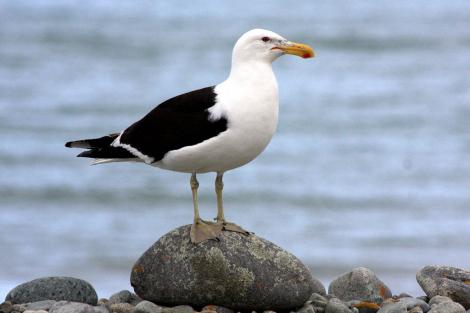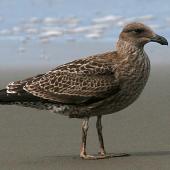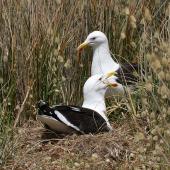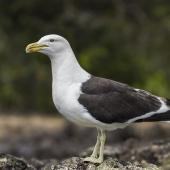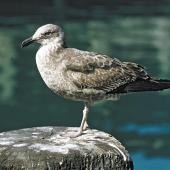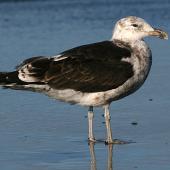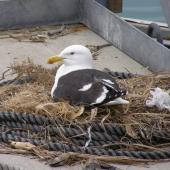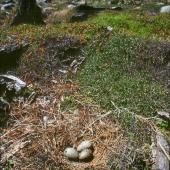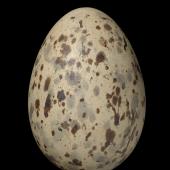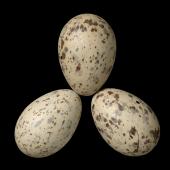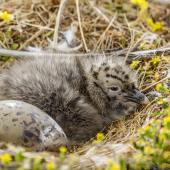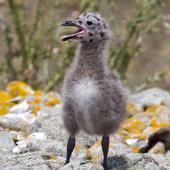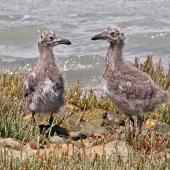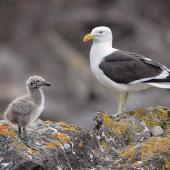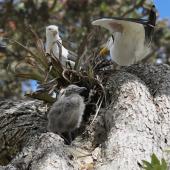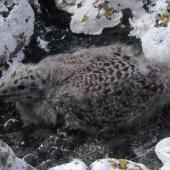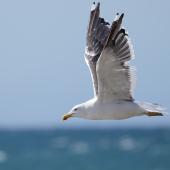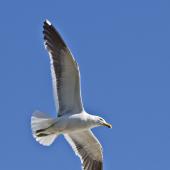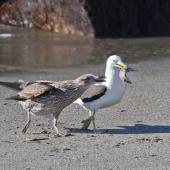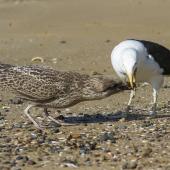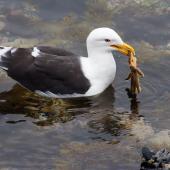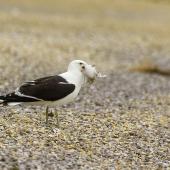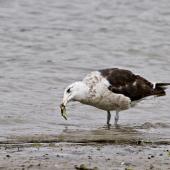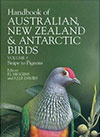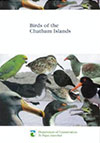Southern black-backed gull | Karoro
Larus dominicanus Lichtenstein, 1823
Order: Charadriiformes
Family: Laridae
New Zealand status: Native
Conservation status: Not Threatened
Other names: kelp gull, dominican gull, black-backed gull, mollyhawk, seagull, blackbacked gull, black backed gull
Geographical variation: Five subspecies recognised; New Zealand birds are of the subspecies dominicanus.
The southern black-backed gull (or ‘black-back’) is one of the most abundant and familiar large birds in New Zealand, although many people do not realise that the mottled brown juveniles (mistakenly called “mollyhawks”) are the same species as the immaculate adults. Found on or over all non-forested habitats from coastal waters to high-country farms, this is the only large gull found in New Zealand. They are particularly abundant at landfills, around ports and at fish-processing plants.
Known widely as ‘kelp gull’ in other countries, the same species is also common in similar latitudes around the southern hemisphere, including southern Australia, South America, southern Africa, and most subantarctic and peri-Antarctic islands, and the Antarctic Peninsula.
Identification
The familiar large gull throughout New Zealand. Adults have white head and underparts with black back, yellow bill with red spot near tip of lower mandible, and pale green legs. Juveniles are dark mottled brown with black bill and legs; their plumage lightens with age until they moult into adult plumage at 3 years old.
Voice: a long series of loud calls ‘ee-ah-ha-ha-ha’ etc, given in territorial and aggressive contexts.
Similar species: adults unmistakeable apart from possible vagrant Pacific gull from Australia (which has a more massive bill, and a black subterminal tip to tail). Juveniles may be confused with the more robust brown skua, which has broader wings with a pale flash at the base of the primaries.
Distribution and habitat
Throughout New Zealand in most habitats other than forest and scrub. Abundant anywhere food scraps, offal and other organic waste can be obtained, including landfills and wharves. Common in estuaries and harbours, rocky and sandy shores and riverbeds; occurs more sparsely inland over farmland, and even subalpine tussockland and herbfields. The largest breeding colonies are on islands, steep headlands, sand or shingle spits, or on islands in shingle riverbeds. Breeds on most outlying islands; vagrant to Kermadec Is and Ross Sea.
Population
Very abundant: hundreds of colonies throughout the country, many exceeding 100 pairs, and a few exceeding 1000 pairs. Often gathers in large feeding and roosting flocks.
Ecological and economic impacts
One of only two native bird species not afforded any level of protection under the Wildlife Act. Black-backed gulls are often considered pests, especially at airports (where they are a major cause of bird-strike), and on farmland, where some attack cast sheep and newborn lambs. As a result, they are sometimes shot, or controlled using toxins or by pricking their eggs. At a few sites, they are controlled to reduce their predatory impacts on threatened shorebirds, e.g. New Zealand dotterel, shore plover and fairy tern.
Breeding
Colonial or solitary; monogamous, with shared incubation and chick care. Nest a bulky collection of grass, small sticks or seaweed, or a simple scrape in sand or shingle. Clutch 2-3 large grey-green eggs with dark brown spots and blotches. Laying mainly Oct-Jan. Incubation 23-26 days; chicks fledge at about 7-8 weeks old, and are fed by adults for at least another month.
Behaviour and ecology
Bold and conspicuous, black-backed gulls are often attracted to food sources provided inadvertently or deliberately by people. In cities, they often roost and even nest on roofs. They are common in urban parks, seeking hand-outs and scraps, or harvesting earthworms from water-logged playing fields. Black-backed gulls are often seen on the water’s edge where they scavenge corpses and fish frames washed up on the tide. Flocks follow ploughs or inshore fishing boats with equal vigour. Nest sites and colonies are defended with loud, persistent calls; some will swoop at human intruders, but they are typically wary, and never make contact (unlike skuas and some terns). Black-backed gulls are harried by smaller gulls and terns when they approach their nesting colonies, although they often nest in close proximity.
Generally considered ‘super-abundant’ due to increased food supply from human sources, there are only a few remote island groups where black-backed gulls occur at what are considered natural densities, with isolated pairs breeding on rock stacks and headlands.
Food
Black-backed gulls are both predators and scavengers, and have been recorded catching and consuming a wide range of marine and terrestrial invertebrates, fish, small mammals, birds and their eggs and chicks. They consume large quantities of organic waste from landfills and farms (e.g. docked lambs’ tails), plus offal from fishing boats and processing factories. Flocks gather at stranded or floating marine mammal carcasses, plus dead farm stock, where they consume both flesh and maggots.
Weblinks
References
Fordham, R.A. 1968. Dispersion and dispersal of the Dominican gull in Wellington, New Zealand. Proceedings of the New Zealand Ecological Society 15: 40-50.
Heather, B.D.; Robertson, H.A. 1996. The field guide to the birds of New Zealand. Viking, Auckland.
Higgins, P.J.; Davies, S.J.J.F. (eds) 1996. Handbook of Australian, New Zealand and Antarctic birds. Vol. 3. Snipe to pigeons. Oxford University Press, Melbourne.
Recommended citation
Miskelly, C.M. 2013 [updated 2022]. Southern black-backed gull | karoro. In Miskelly, C.M. (ed.) New Zealand Birds Online. www.nzbirdsonline.org.nz
Southern black-backed gull | Karoro
- Social structure
- monogamous
- Breeding season
-
- Jul
- Aug
- Sep
- Oct
- Nov
- Dec
- Jan
- Feb
- Mar
- Apr
- May
- Jun
- Nest type
- ground-level platform, lined scrape, scrape
- Nest description
- Bulky collection of grass, small sticks or seaweed, or a simple scrape in sand or shingle
- Nest height (mean)
- 0 m
- Clutch size (min)
- 2
- Clutch size (max)
- 3
- Mean egg dimensions (length)
- 69 mm
- Mean egg dimensions (width)
- 47 mm
- Egg colour
- grey-green with dark brown spots and blotches
- Egg laying dates
-
- Jul
- Aug
- Sep
- Oct
- Nov
- Dec
- Jan
- Feb
- Mar
- Apr
- May
- Jun
- Incubation behaviour
- shared
- Incubation length (min)
- 23 days
- Incubation length (max)
- 26 days
- Nestling type
- semi-precocial
- Age at fledging (mean)
- 45-61 days
- Age at fledging (min)
- 45 days
- Age at fledging (max)
- 61 days
- Age at first breeding (min)
- 3 years
- Maximum longevity
- 28 years
- Maximum dispersal
- 480 km




